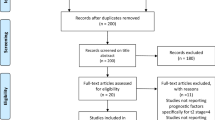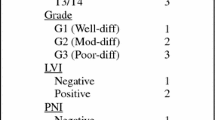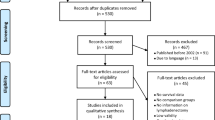Abstract
Introduction
The 5-year survival of patients with gallbladder cancer remains low. However, patients can be stratified into prognostic categories based on established factors such as T, N, and R status. New concepts regarding prognostic significance of lymph node disease, the importance of residual gallbladder fossa disease, and the gravity of presentation with jaundice are reviewed. In addition, a number of new prognostic factors proposed in recent years are considered.
Methods
PubMed was searched for “gallbladder cancer” with builder “date-completion” 2008 to present. A total of 1,490 articles were screened from which 168 were retrieved. From this, 40 articles specifically related to prognosis form the basis for this review.
Discussion
Key factors of prognostic significance remain T and N stage and R0 resection. Residual disease either in the gallbladder fossa, lymph nodes, or cystic duct margin dictates hepatectomy, lymphadenectomy and bile duct resection, respectively. Adequate lymphadenectomy requires removal of six nodes, and hepatectomy must be sufficient to achieve R0. Subtleties regarding lymph node ratio, significance of pathological features such as dedifferentiation, and budding may hold value for stratifying patients with early stage disease, but require further investigation.

Similar content being viewed by others
References
Butte JM, Matsuo K, Gonen M, et al. Gallbladder cancer: differences in presentation, surgical treatment, and survival in patients treated at centers in three countries. J Am Coll Surg. 2011;212:50–61.
Edge SB, American Joint Committee on Cancer, American Cancer Society. AJCC Cancer Staging Handbook: From the AJCC Cancer Staging Manual. New York: Springer; 2010.
Benson AB, Abrams TA, Ben-Josef E, et al. NCCN Clinical Practice Guidelines in Oncology: Hepatobiliary Cancers. Version 2.2012. Available at: http://www.nccn.org/professionals/physician_gls/pdf/hepatobiliary.pdf. Accessed 1 March 2013.
Greene FL, American Joint Committee on Cancer, American Cancer Society. AJCC Cancer Staging Handbook: From the AJCC Cancer Staging Manual. New York: Springer; 2002.
House MG, Gonen M, Jarnagin WR, et al. Prognostic significance of pathologic nodal status in patients with resected pancreatic cancer. J Gastrointest Surg. 2007;11:1549–1555.
Pawlik TM, Gleisner AL, Cameron JL, et al. Prognostic relevance of lymph node ratio following pancreaticoduodenectomy for pancreatic cancer. Surgery. 2007;141:610–618.
Ito H, Ito K, D’Angelica M, et al. Accurate staging for gallbladder cancer: implications for surgical therapy and pathological assessment. Ann Surg. 2011;254:320–325.
Negi SS, Singh A, Chaudhary A. Lymph nodal involvement as prognostic factor in gallbladder cancer: location, count or ratio? J Gastrointest Surg. 2011;15:1017–1025.
Shirai Y, Sakata J, Wakai T, et al. Assessment of lymph node status in gallbladder cancer: location, number, or ratio of positive nodes. World J Surg Oncol. 2012;10:87.
Mayo SC, Shore AD, Nathan H, et al. National trends in the management and survival of surgically managed gallbladder adenocarcinoma over 15 years: a population-based analysis. J Gastrointest Surg. 2010;14:1578–1591.
Downing SR, Cadogan KA, Ortega G, et al. Early-stage gallbladder cancer in the surveillance, epidemiology, and end results database: effect of extended surgical resection. Arch Surg. 2011;146:734–738.
Sakata J, Shirai Y, Wakai T, et al. Number of positive lymph nodes independently determines the prognosis after resection in patients with gallbladder carcinoma. Ann Surg Oncol. 2010;17:1831–1840.
Sasaki E, Nagino M, Ebata T, et al. Immunohistochemically demonstrated lymph node micrometastasis and prognosis in patients with gallbladder carcinoma. Ann Surg. 2006;244:99–105.
Tanabe M, Endo I, Masunari H, et al. Is lymph-node micrometastasis in gallbladder cancer a significant prognostic factor? Hepatogastroenterology. 2012;59:31–35.
Bartlett DL, Fong Y, Fortner JG, et al. Long-term results after resection for gallbladder cancer. Implications for staging and management. Ann Surg. 1996;224:639–646.
Lowe K, Khithani A, Mejia A, et al. All lymph node positive patients are not equal: a new paradigm in gallbladder cancer. Am Surg. 2012;78:147–148.
Jensen EH, Abraham A, Jarosek S, et al. Lymph node evaluation is associated with improved survival after surgery for early stage gallbladder cancer. Surgery. 2009;146:706–711; discussion 711–703.
Ito H, Matros E, Brooks DC, et al. Treatment outcomes associated with surgery for gallbladder cancer: a 20-year experience. J Gastrointest Surg. 2004;8:183–190.
Aramaki M, Matsumoto T, Shibata K, et al. Factors influencing recurrence after surgical treatment for T2 gallbladder carcinoma. Hepatogastroenterology. 2004;51:1609–1611.
de Aretxabala X, Roa I, Hepp J, et al. Early gallbladder cancer: is further treatment necessary? J Surg Oncol. 2009;100:589–593.
Lendoire JC, Gil L, Duek F, et al. Relevance of residual disease after liver resection for incidental gallbladder cancer. HPB (Oxford). 2012;14:548–553.
Fetzner UK, Holscher AH, Stippel DL. Regional lymphadenectomy strongly recommended in T1b gallbladder cancer. World J Gastroenterol. 2011;17:4347–4348.
Pawlik TM, Gleisner AL, Vigano L, et al. Incidence of finding residual disease for incidental gallbladder carcinoma: implications for re-resection. J Gastrointest Surg. 2007;11:1478–1486; discussion 1486–1477.
Choi SB, Han HJ, Kim CY, et al. Surgical outcomes and prognostic factors for T2 gallbladder cancer following surgical resection. J Gastrointest Surg. 2010;14:668–678.
Chakravarty KD, Yeh CN, Jan YY, Chen MF. Factors influencing long-term survival in patients with T3 gallbladder adenocarcinoma. Digestion. 2009;79:151–157.
Nakata T, Kobayashi A, Miwa S, et al. Impact of tumor spread to the cystic duct on the prognosis of patients with gallbladder carcinoma. World J Surg. 2007;31:155–161; discussion 162–153.
Pawlik TM, Choti MA. Biology dictates prognosis following resection of gallbladder carcinoma: sometimes less is more. Ann Surg Oncol. 2009;16:787–788.
Araida T, Higuchi R, Hamano M, et al. Should the extrahepatic bile duct be resected or preserved in R0 radical surgery for advanced gallbladder carcinoma? Results of a Japanese Society of Biliary Surgery Survey: a multicenter study. Surg Today. 2009;39:770–779.
Bickenbach KA, Shia J, Klimstra DS, et al. High-grade dysplasia of the cystic duct margin in the absence of malignancy after cholecystectomy. HPB (Oxford). 2011;13:865–868.
Hawkins WG, DeMatteo RP, Jarnagin WR, et al. Jaundice predicts advanced disease and early mortality in patients with gallbladder cancer. Ann Surg Oncol. 2004;11:310–315.
Regimbeau JM, Fuks D, Bachellier P, et al. Prognostic value of jaundice in patients with gallbladder cancer by the AFC-GBC-2009 study group. Eur J Surg Oncol. 2011;37:505–512.
Varma V, Gupta S, Soin AS, Nundy S. Does the presence of jaundice and/or a lump in a patient with gall bladder cancer mean that the lesion is not resectable? Dig Surg. 2009;26:306–311.
Kai K, Kohya N, Kitahara K, et al. Tumor budding and dedifferentiation in gallbladder carcinoma: potential for the prognostic factors in T2 lesions. Virchows Archiv. 2011;459:449–456.
Miura F, Asano T, Amano H, et al. New prognostic factor influencing long-term survival of patients with advanced gallbladder carcinoma. Surgery. 2010;148:271–277.
Murakami Y, Uemura K, Sudo T, et al. Prognostic factors of patients with advanced gallbladder carcinoma following aggressive surgical resection. J Gastrointest Surg. 2011;15:1007–1016.
Kobayashi A, Oda T, Fukunaga K, et al. Invasion of the hepatic artery is a crucial predictor of poor outcomes in gallbladder carcinoma. World J Surg. 2012;36:645–650.
Pilgrim C, Usatoff V, Evans PM. A review of the surgical strategies for the management of gallbladder carcinoma based on T stage and growth type of the tumour. Eur J Surg Oncol. 2009;35:903–907.
Steinert R, Nestler G, Sagynaliev E, et al. Laparoscopic cholecystectomy and gallbladder cancer. J Surg Oncol. 2006;93:682–689.
Lee JM, Kim BW, Kim WH, et al. Clinical implication of bile spillage in patients undergoing laparoscopic cholecystectomy for gallbladder cancer. Am Surg. 2011;77:697–701.
Maker AV, Butte JM, Oxenberg J, et al. Is port site resection necessary in the surgical management of gallbladder cancer? Ann Surg Oncol. 2012;19:409–417.
Han HS, Cho JY, Yoon YS, et al. Preoperative inflammation is a prognostic factor for gallbladder carcinoma. Br J Surg. 2011;98:111–116.
He XD, Liu W, Tao LY, et al. Gender-specific prognostic markers of patients with gallbladder cancer after surgical resection. Am Surg. 2010;76:1269–1274.
Katz MH, Varadhachary GR, Fleming JB, et al. Serum CA 19–9 as a marker of resectability and survival in patients with potentially resectable pancreatic cancer treated with neoadjuvant chemoradiation. Ann Surg Oncol. 2010;17:1794–1801.
Shukla PJ, Neve R, Barreto SG, et al. A new scoring system for gallbladder cancer (aiding treatment algorithm): an analysis of 335 patients. Ann Surg Oncol. 2008;15:3132–3137.
Leon AR. A new scoring system for gallbladder cancer: the first step of a long walk. Ann Surg Oncol. 2008;15:2991–2992.
Conflict of interest
None.
Author information
Authors and Affiliations
Corresponding author
Rights and permissions
About this article
Cite this article
Pilgrim, C.H.C., Groeschl, R.T., Turaga, K.K. et al. Key Factors Influencing Prognosis in Relation to Gallbladder Cancer. Dig Dis Sci 58, 2455–2462 (2013). https://doi.org/10.1007/s10620-013-2713-y
Received:
Accepted:
Published:
Issue Date:
DOI: https://doi.org/10.1007/s10620-013-2713-y




